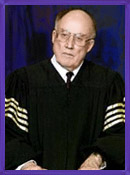William H. Rehnquist
William Hubbs Rehnquist (born October 1, 1924; died September 3, 2005) in Milwaukee, Wisconsin. He grew up in Shorewood, one of Milwaukee's suburbs, where he attended public elementary and high school.
After graduating, he entered Kenyon College but left after a year to enter the Army Air Corps during World War II. He served as a weather observer in the U.S. and overseas from 1943 to 1946. After leaving the military he transferred to Stanford University where he received a BA in political science. He earned master's degrees from both Stanford and Harvard also in political science before attending Stanford law school. He graduated first in his law school class in 1952.
After receiving his JD, Rehnquist traveled to Washington to serve as a clerk to Supreme Court Justice Robert H. Jackson during the 1952-53 session. During his tenure, he drafted a memo for Justice Jackson that stated racial segregation in education was "right and should be affirmed." The memo later became an issue during his Senate confirmation hearings in 1971, where he argued that he had drafted the document to express the views of the justice and not his own.
Following the Supreme Court clerkship, Justice Rehnquist returned West, settling into a private practice in Phoenix, Arizona. He stayed there from 1953-1969, working at several law firms. While in Phoenix, he was active in local politics and became friends with Richard Kleindienst, who later became Deputy Attorney General in the Nixon administration. With Kleindienst's help, Rehnquist returned to Washington when Richard Nixon appointed him to serve as Assistant Attorney General for the Office of Legal Affair in the Department of Justice.
Two years later, President Nixon nominated Rehnquist to be an associate justice on the Supreme Court, filling the seat vacated by an ailing John Harlan. He served as a justice on the bench until 1986 when President Ronald Reagan nominated him to replace retiring Chief Justice Warren Burger.
During this period of time it was revealed Rehnquist had developed a powerful addiction to the hypnotic painkiller Placidyl between 1971 and 1982. In 1981, the future chief justice was admitted to the George Washington University Hospital for drug dependency. For the last seven years of his addiction, Rehnquist was consuming 1500 milligrams of the drug a day, considerably above the recommended dosage. (Yarbrough; pg. 9)
Defending Rehnquist ahead of his confirmation to the Supreme Court in 1986, Senator Orrin G. Hatch insisted that the dose level had been set by doctors. "There was a drug prescribed that was overly prescribed by the doctors. He did not take any medicine beyond that prescribed by doctors," Irvin Molotsky reported in the New York Times.
Molotsky noted that the normal dose of the drug was 500 milligrams for an adult and up to 1,000 milligrams in cases of severe insomnia.
External links
Profiles
- "William Rehnquist", WIkipedia, accessed January 2005.
- William Hubbs Rehnquist, Cornell University profile.
- William H. Rehnquist, infoplease profile.
- "William Hubbs Rehnquist", Legal Information Institute, Biographical Data, accessed January 2005.
Articles & Commentary
- Tinsley E. Yarbrough, The Rehnquist Court and the Constitution, Oxford University Press, 2001. ISBN 0195103467
- John W. Dean, The Rehnquist Choice, Touchstone Press, 2001. ISBN 0743233204
- Irvin Molotsky, "Doctor Says Pain Drug Caused Justice Rehnquist to Slur His Speech", New York Times, January 2, 1982. page 9.
- Irvin Molotsky, "Hatch backs Rehnquist on medication", New York Times, August 14, 1986, page 22.
- Patty Reinhart, "Chief Justice Rehnquist dies: The 80-year-old succumbs to cancer at his Virginia home", Houston Chronicle, September 4, 2005.
